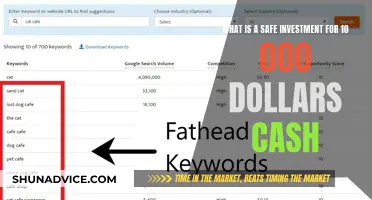
A 401(k) is a tax-advantaged retirement savings plan offered by employers to help their employees save for retirement. Named after a section of the US Internal Revenue Code, the 401(k) is an employer-provided, defined-contribution plan. Employees can contribute a percentage of their income to their 401(k) account, and employers often match these contributions. There are two main types of 401(k) plans: traditional and Roth. The difference lies in the timing of tax payments. With a traditional 401(k), contributions are made pre-tax, reducing taxable income, but withdrawals in retirement are taxed. On the other hand, Roth 401(k) contributions are made with after-tax income, and withdrawals are tax-free.
| Characteristics | Values |
|---|---|
| Type of plan | Retirement savings plan |
| Who offers it | Employers |
| Who can contribute | Employees |
| Tax advantages | Yes |
| Types | Traditional, Roth, self-employed |
| Investment options | Mutual funds, exchange-traded funds, target-date funds, index funds |
| Annual contribution limit (2024) | $23,000 |
| Catch-up contribution limit (2024) | $7,500 |
| Combined contribution limit (2024) | $69,000 |
| Combined contribution limit with catch-up (2024) | $76,500 |
| Early withdrawal penalty | 10% |
| Minimum distribution age | 59 1/2 |
What You'll Learn

How does a 401(k) work?
A 401(k) is a tax-advantaged retirement savings plan, named after a section of the US Internal Revenue Code. It is a company-sponsored retirement account, where employees can contribute a percentage of their income.
When an employee signs up for a 401(k), they agree to put a percentage of each paycheck directly into an investment account. Employers often match part or all of that contribution. Employees can then choose how to invest the money in their account, typically in mutual funds or exchange-traded funds.
There are two main types of 401(k)s: traditional and Roth. With a traditional 401(k), contributions are taken from an employee's paycheck before taxes are deducted, so their taxable income is reduced. However, withdrawals in retirement are taxed. With a Roth 401(k), contributions are made with after-tax income, so there is no upfront tax break, but withdrawals are tax-free.
The main difference between the two types of 401(k) is when taxes are paid. With a traditional 401(k), taxes are paid when money is withdrawn during retirement, whereas with a Roth 401(k), taxes are paid upfront, so there are no taxes to pay on withdrawals.
There are annual limits on how much an individual can contribute to a 401(k). In 2024, the limit is $23,000, or $30,500 for those aged 50 or over.
Some employers offer a third type of 401(k) called a "Roth 401(k)", which has features of both the traditional and Roth versions. With this type of 401(k), employees can contribute after-tax income and won't have to pay taxes on withdrawals in retirement.
Employers may also offer a vesting period, where employees gradually take ownership of the company's matching contributions over several years. This incentivises employees to stay with the company.
When an employee leaves a job, they can take their 401(k) with them and roll it over into a new employer's plan or into an IRA. They could also leave it with their old employer, depending on the plan's rules.
Yotta Savings: A Smart Investment Strategy for Your Money
You may want to see also

What are the types of 401(k) plans?
There are two main types of 401(k) plans: the traditional 401(k) and the Roth 401(k). They are differentiated by their tax advantages.
With a traditional 401(k), contributions are taken out of an employee's paycheck before the IRS takes its cut, and the money grows tax-free. However, withdrawals from the account in retirement are taxed.
With a Roth 401(k), contributions are made with after-tax income. This means that withdrawals can be made tax-free in retirement.
While traditional 401(k) plans are more common, many employers now also offer Roth 401(k)s.
Savings vs. Investments: What's the Difference?
You may want to see also

What are the pros and cons of a 401(k)?
A 401(k) is a tax-advantaged retirement savings plan. Here are some pros and cons of a 401(k) plan:
Pros
- It's an easy way to save for the future, with many employers offering automatic enrolment and immediate participation.
- It's a form of "forced savings", as contributions are taken directly from your paycheck, so you save without even noticing.
- It has high contribution limits compared to other retirement accounts, such as IRAs.
- It offers tax benefits, with tax-free growth and upfront tax deductions depending on the type of 401(k) chosen.
- Many employers offer matching contributions, which is essentially "free money" to boost your retirement savings.
- You can borrow money from your 401(k) in times of need.
- Professionals manage your investment choices, and you can choose from a menu of mutual funds.
Cons
- You might not be able to save enough in a 401(k) alone for retirement, especially if your employer's contributions are minimal.
- 401(k) plans often have higher fees, and it can be difficult to understand all the fees being charged.
- Your money is tied up until retirement, and early withdrawals usually incur high penalties and taxes.
- Traditional 401(k)s are subject to required minimum distributions (RMDs) after a certain age.
- Investment choices are limited compared to other accounts, such as IRAs.
National Saving Certificates: Smart Investment Strategies
You may want to see also

What are the 401(k) withdrawal rules?
Generally, you can't withdraw from a 401(k) plan until one of the following happens:
- You leave your job due to death or become disabled
- The plan is terminated and isn't replaced by a new one
- You experience a financial hardship
- You reach the age of 59½
If you withdraw before the age of 59½, you will likely owe:
- Federal income tax (taxed at your marginal tax rate)
- A 10% penalty on the amount that you withdraw
- Relevant state income tax
There are some exceptions to the 10% penalty rule, including:
- Birth or adoption: You can withdraw up to $5,000 per child for qualified birth or adoption expenses
- Death or disability: You won't pay the 10% penalty if you're totally and permanently disabled or you're an account beneficiary and the account owner has passed away
- Disaster recovery distribution: If you have economic loss due to a federally declared disaster, you can withdraw up to $22,000
- Domestic abuse victim distribution: Victims of domestic abuse can withdraw $10,000 or 50% of their account, whichever is lower
- Emergency personal expense: You may withdraw up to $1,000 each year for personal or family emergency expenses
- Equal payments: You can take penalty-free withdrawals if you take a series of substantially equal payments
- Medical expenses: You can withdraw the amount of unreimbursed medical expenses that exceed 7.5% of your AGI
- Military: If you're a qualified military reservist who's been called to active duty, certain distributions can be made penalty-free
- Separation from service: You won't pay the penalty on withdrawals if you leave your job during or after the year you turn 55 (50 for certain government employees)
Once you reach age 73, you are required to begin taking required minimum distributions (RMDs) from your 401(k) each year unless you're still working and choose to defer until retirement.
Investment Options for College Savings: What Are Your Choices?
You may want to see also

What happens to my 401(k) if I quit my job?
If you quit your job, you can take your 401(k) money with you. You have several options for what to do with your 401(k) money:
Keep the money in your former employer's plan
If you have more than $5,000 or 7,000 invested in your 401(k), most plans allow you to leave it where it is after you separate from your employer. If you have a substantial amount saved and like your plan portfolio, then leaving your 401(k) in the account may be a good idea. If you are likely to forget about the account or are not particularly impressed with the plan's investment options or fees, consider some of the other options.
If you leave your 401(k) with your old employer, you will no longer be allowed to make contributions to the plan. It will still be invested as it was, and you can work with the 401(k) provider to change your investments if you so choose.
Roll your 401(k) to your new employer
If your new employer offers a 401(k) plan with low costs and a wide variety of investment options, this might be a viable option to consider.
If you are interested in rolling the money over into your new employer's 401(k), meet with the HR department or retirement plan representative to find out more about your new company's plan. See whether you will be allowed to participate as soon as you're hired or will have to work for a certain number of days before you're eligible.
To accomplish this rollover, instruct the administrator of your former employer's 401(k) to roll over your assets to your new employer's plan once your account has been established. Alternatively, you can instruct the former employer's 401(k) administrator to send you a check — but you must deposit the funds into your new employer's plan within 60 days to avoid paying income tax and a potential penalty on distribution.
Roll your 401(k) to an IRA
If your new employer doesn't offer a 401(k), or you're not pleased with the plan's costs or investment options, this may be a good option because it will give you flexibility and control to stay on track with your retirement savings goals. IRAs generally have more investment options, no or low administration fees, and greater withdrawal flexibility.
In order to execute a rollover to an IRA, your first step is to open a new IRA with a financial institution if you don't already have one. The rollover process is similar to the one described above except that you have to instruct the administrator of your former employer's 401(k) to roll over your plan assets to your IRA.
Conversely, you can have a check sent directly to you. The former plan administrator will withhold 20% of the amount for the payment of taxes, and you will have 60 days to deposit the full balance, including the 20% withheld, into your IRA. Failure to deposit the entire amount into your IRA could result in current tax liabilities plus a 10% penalty if you're younger than 59½ on the amount that was not deposited in your IRA.
Take the cash
Of course, you can just take the money and run. Nothing is stopping you from liquidating an old 401(k) and taking a lump-sum distribution, but most financial advisors caution strongly against it. It reduces your retirement savings unnecessarily, and on top of that, you will be taxed on the entire amount.
If you have a large sum in an old account, then the tax burden of a full withdrawal may not be worth the windfall. Plus, you may be subject to the 10% early withdrawal penalty.
Saving and Investing: Strategies for Future Financial Goals
You may want to see also
Frequently asked questions
A 401(k) is a tax-advantaged retirement savings plan offered by an employer. It is named after a section of the U.S. Internal Revenue Code. Employees can contribute a percentage of their income to the plan, and employers often match these contributions.
The two main types of 401(k) plans are traditional and Roth. The difference lies in their tax advantages. With a traditional 401(k), contributions are made pre-tax, reducing taxable income, but withdrawals in retirement are taxed. On the other hand, Roth 401(k)s are funded with after-tax income, so there is no immediate tax benefit, but withdrawals are tax-free.
According to IRS rules, you cannot withdraw funds from a 401(k) without penalty until you reach the age of 59 1/2. Early withdrawals may be subject to a 10% tax penalty, and the withdrawn amount must be included as taxable income. Once you turn 72, you are required to withdraw a minimum amount each year, known as required minimum distributions (RMDs).







